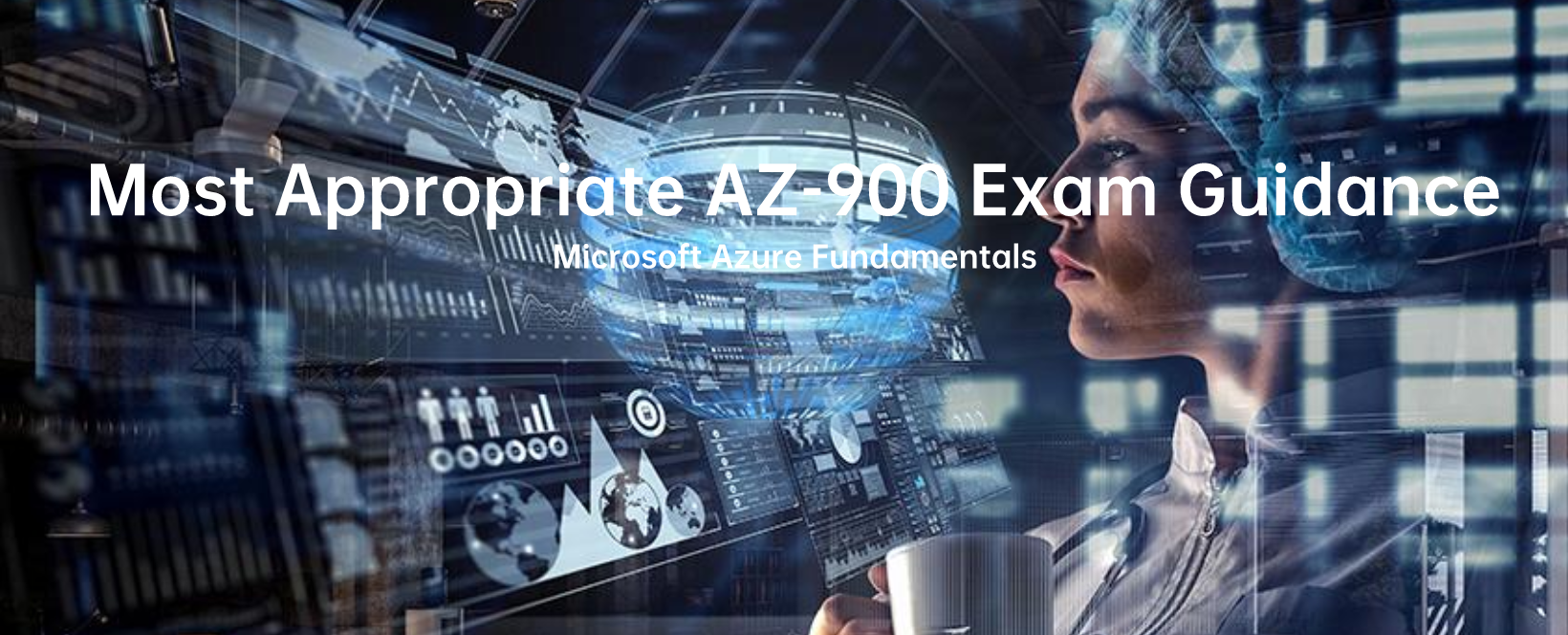
As the Microsoft MD-101 exam became popular, hundreds or thousands of exam material providers offered MD-101 dumps.
On the one hand, this is a good thing, as it gives us test takers a wide range of options. The competition will provide additional advantages (special offers, lower fees, etc.).
On the other hand, such a wide range of options can be a headache because test takers often fall into the trap of unfair businessmen.
Therefore, you have to choose which MD-101 dumps to invest your hard-earned money in.
It’s not that hard – just start with the following:
Whether to provide you with personalized services in a simple and convenient purchase page (such as MD-101 dumps presented in PDF and VCE format, diversified options).
- Whether the MD-101 dumps price is moderate so that most test takers do not have financial pressure.
- Do not cheat the facts under the guise of free exam questions. There is no need to spend expensive fees to register as a member to enjoy the service.
- Whether the MD-101 dumps question can be updated as the exam is updated and no longer charged twice, is not obsolete material.
Using valid MD-101 dumps is the best way to pass the Managing Modern Desktops exam, so two reliable options are recommended:
Pass4itSure MD-101 dumps https://www.pass4itsure.com/md-101.html (real questions 414, PDF+VCE, cost $45.99-$50.99, free update).
MeasureUp practice test for Managing Modern Desktops: https://www.mindhub.com/md-101-managing-modern-desktops-microsoft-official-practice-test/p/MU-MD-101?utm_source=microsoft&utm_medium=certpage&utm_campaign=msofficialpractice (Costs $99.00 – $109.00).
Next, share some helpful free MD-101 dumps questions:
Q1:
Which user can enroll Device6 in Intune?
A. User4 and User2 only
B. User4 and User1 only
C. User4, User1, and User2 only
D. User1, User2, User3, and User4
Correct Answer: D
All the users can enroll devices in Intune.
Q2:
Note: This question is part of a series of questions that present the same scenario. Each question in the series contains a unique solution that might meet the stated goals. Some question sets might have more than one correct solution, while others might not have a correct solution.
After you answer a question in this section, you will NOT be able to return to it. As a result, these questions will not appear on the review screen.
Your network contains an Active Directory domain. The domain contains a computer named Computer1 that runs Windows 8.1. Computer1 has apps that are compatible with Windows 10.
You need to perform a Windows 10 in-place upgrade on Computer1.
Solution: You copy the Windows 10 installation media to a network share. You start Computer1 from Windows PE (WinPE), and then you run setup.exe from the network share. Does this meet the goal?
A. Yes
B. No
Correct Answer: A
Reference: https://docs.microsoft.com/en-us/windows/deployment/windows-deployment-scenarios-and-tools
Q3:
You have a Microsoft 365 tenant that contains the devices shown in the following table.
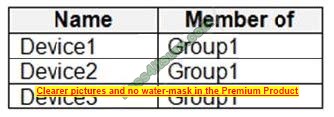
The devices are managed by using Microsoft Intune.
You create a compliance policy named Policy1 and assign Policy1 to Group1. Policy1 is configured to mark a device as Compliant only if the device security settings match the settings specified in the policy.
You discover that devices that are not members of Group 1 are shown as Compliant.
You need to ensure that only devices that are assigned a compliance policy can be shown as Compliant. All other devices must be shown as Not compliant.
What should you do?
A. From Endpoint security, configure the Conditional access settings.
B. From Device compliance, configure the Compliance policy settings.
C. From Policy 1, modify the actions for noncompliance.
D. From Tenant administration, modify the Diagnostic settings.
Correct Answer: B
There are two parts to compliance policies in Intune:
Compliance policy settings Tenant-wide settings are like a built-in compliance policy that every device receives.
Compliance policy settings set a baseline for how compliance policy works in your Intune environment, including whether devices that haven’t received any device compliance policies are compliant or non-compliant.
Device compliance policy Platform-specific rules you configure and deploy to groups of users or devices. These rules define requirements for devices, like minimum operating systems or the use of disk encryption. Devices must meet these rules to be considered compliant.
Reference:
https://docs.microsoft.com/en-us/mem/intune/protect/device-compliance-get-started
Q4:
Note: This question is part of a series of questions that present the same scenario. Each question in the series contains a unique solution that might meet the stated goals. Some question sets might have more than one correct solution, while others might not have a correct solution.
After you answer a question in this section, you will NOT be able to return to it. As a result, these questions will not appear on the review screen.
Your network contains an Active Directory domain. The domain contains a computer named Computer1 that runs Windows 8.1. Computer1 has apps that are compatible with Windows 10. You need to perform a Windows 10 in-place upgrade on Computer1.
Solution: Add Windows 10 startup and install images to a Windows Deployment Services (WDS) server. You start Computer1 using WDS and PXE, then initiate the Windows 10 installation.
Does this meet the goal?
A. Yes
B. No
Correct Answer: A
Reference: https://docs.microsoft.com/en-us/windows/deployment/windows-deployment-scenarios-and-tools
Q5:
HOTSPOT
You have a server named Server1 and computers that run Windows 8.1. Server1 has the Microsoft Deployment Toolkit (MDT) installed.
You plan to upgrade the Windows 8.1 computers to Windows 10 by using the MDT deployment wizard.
It would help if you created a deployment share on Server1.
What should you do on Server1, and what are the minimum components you should add to the MDT deployment share? To answer, select the appropriate options in the answer area. NOTE: Each correct selection is worth one point.
Hot Area:

Correct Answer:
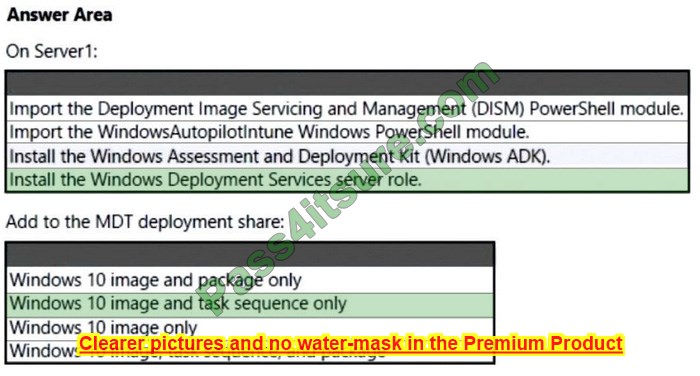
Box 1: Install the Windows Deployment Services role.
Install and initialize Windows Deployment Services (WDS)
On the server:
Open an elevated Windows PowerShell prompt and enter the following command:
Install-WindowsFeature -Name WDS -IncludeManagementTools
WDSUTIL /Verbose /Progress /Initialize-Server /Server: MDT01 /RemInst: “D:\RemoteInstall”
WDSUTIL /Set-Server /AnswerClients: All
Incorrect:
* Install the Windows Assessment and Deployment Kit (Windows ADK) MDT installation requires the ADK, but MDT is already installed.
Box 2: Windows 10 image and task sequence only
Create the reference image task sequence
In order to build and capture your Windows 10 reference image for deployment using MDT, you will create a task sequence.
Reference:
https://docs.microsoft.com/en-us/windows/deployment/deploy-windows-mdt/prepare-for-windows-deployment-with-mdt https://docs.microsoft.com/en-us/windows/deployment/deploy-windows-mdt/create-a-windows-10-reference-image
Q6:
DRAG DROP
Your company has a Microsoft 365 E5 tenant.
All the devices of the company are enrolled in Microsoft Endpoint Manager.
You need to create advanced reports by using custom queries and visualizations from raw Microsoft Endpoint Manager data.
Which three actions should you perform in sequence? To answer, move the appropriate actions from the list of actions to the answer area and arrange them in the correct order.
Select and Place:
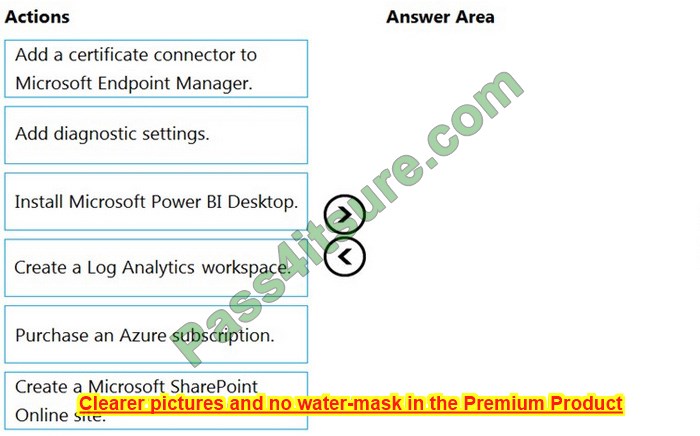
Correct Answer:
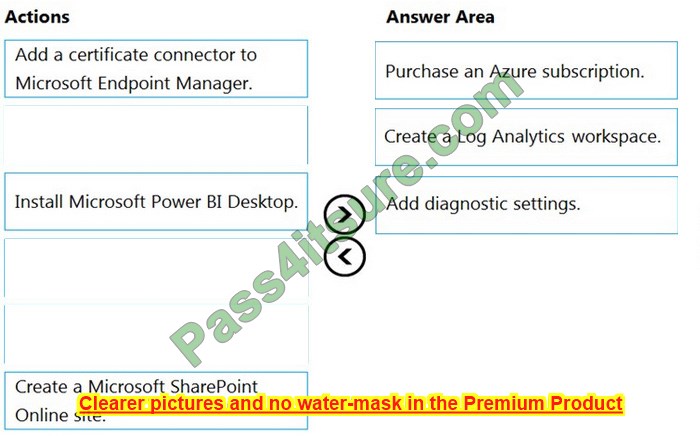
Step 1: Purchase an Azure subscription.
Complex reporting functionality requires an Azure subscription.
Step 2: Create a Log Analytics workspace.
Each Azure resource requires its own diagnostic setting. The diagnostic setting defines the following for a resource:
* One or more destinations to send the logs. Current destinations include Log Analytics workspace, Event Hubs, and Azure Storage.
* Categories of logs and metric data are sent to the destinations defined in the setting. The available categories will vary for different resource types.
* Retention policy for data stored in Azure Storage.
Step 3: Add diagnostic settings.
You can create and view custom reports using the following steps:
1. Sign in to the Microsoft Endpoint Manager admin center.
2. Select Reports > Diagnostic settings and add a diagnostic setting.
3. Etc.
Reference: https://docs.microsoft.com/en-us/mem/intune/fundamentals/reports
Q7:
Your company purchases new computers that run Windows 10. The computers have cameras that support Windows Hello for Business. You configure the Windows Hello for Business Group Policy settings as shown in the following exhibit.
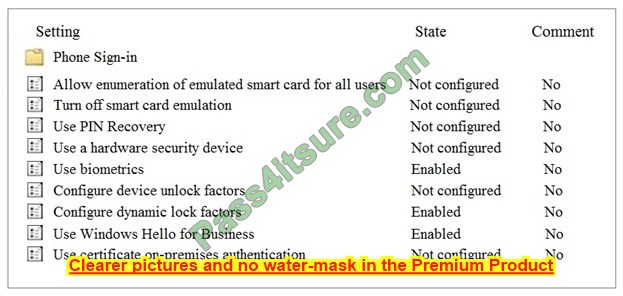
What are two valid methods a user can use to sign in? Each correct answer presents part of the solution. NOTE: Each correct selection is worth one point.
A. Facial recognition
B. A smartwatch that is Bluetooth-enabled
C. A PIN
D. A USB key
Correct Answer: AC
Q8:
Note: This question is part of a series of questions that present the same scenario. Each question in the series contains a unique solution that might meet the stated goals. Some question sets might have more than one correct solution, while others might not have a correct solution.
After you answer a question in this section, you will NOT be able to return to it. As a result, these questions will not appear on the review screen.
You have a Microsoft 365 subscription. You have 20 computers that run Windows 10 and are joined to Microsoft Azure Active Directory (Azure AD). You plan to replace the computers with new computers that run Windows 10. The new computers will be joined to Azure AD.
You need to ensure that the desktop background, the favorites, and the browsing history are available on the new computers. Solution: You configure roaming user profiles. Does this meet the goal?
A. Yes
B. No
Correct Answer: B
Instead: Enterprise State Roaming provides users with a unified experience across their Windows devices and reduces the time needed for configuring a new device.
Reference: https://docs.microsoft.com/en-us/azure/active-directory/devices/enterprise-state-roaming-enable
Q9:
You are currently making use of the Antimalware Assessment solution in Microsoft Azure Log Analytics.
You have accessed the Protection Status dashboard and found a device with no real-time protection.
Which of the following could be a reason for this occurring?
A. Windows Defender has been disabled.
B. You need to install the Azure Diagnostic extension.
C. Windows Defender Credential Guard is incorrectly configured.
D. Windows Defender System Guard is incorrectly configured.
Correct Answer: A
Microsoft Defender Antivirus is usually the primary antivirus/antimalware product on your device. To review the protection status
1. On the Antimalware dashboard, you will review the Protection Status blade and click no real-time protection.
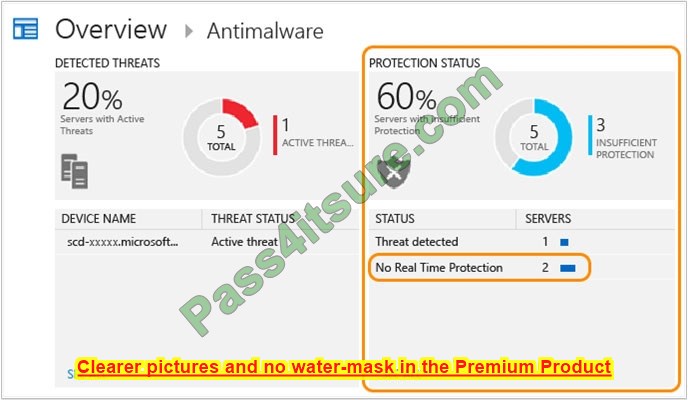
2. Search shows a list of servers without protection.
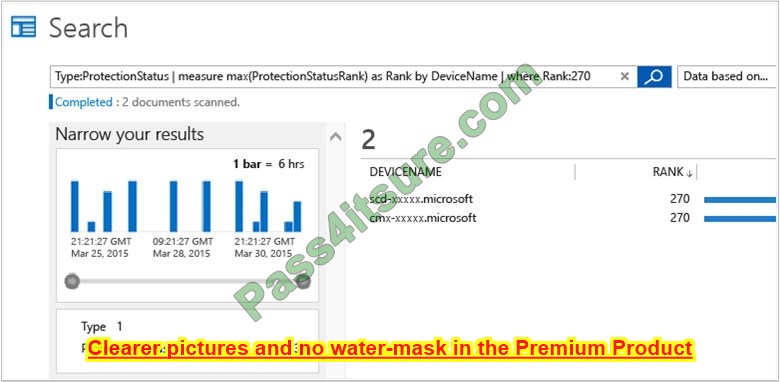
3. At this point you now know what servers do not have real-time protection.
Computers that do not have System Center Endpoint Protection installed (or if SCEP is not detected) will be reported as having no real-time protection.
Reference: https://docs.microsoft.com/ga-ie/azure/security-center/security-center-install-endpoint-protection
Q10:
You need to meet the technical requirements for the LEG department computers.
Which three actions should you perform in sequence? To answer, move the appropriate actions from the list of actions to the answer area and arrange them in the correct order.
Select and Place:
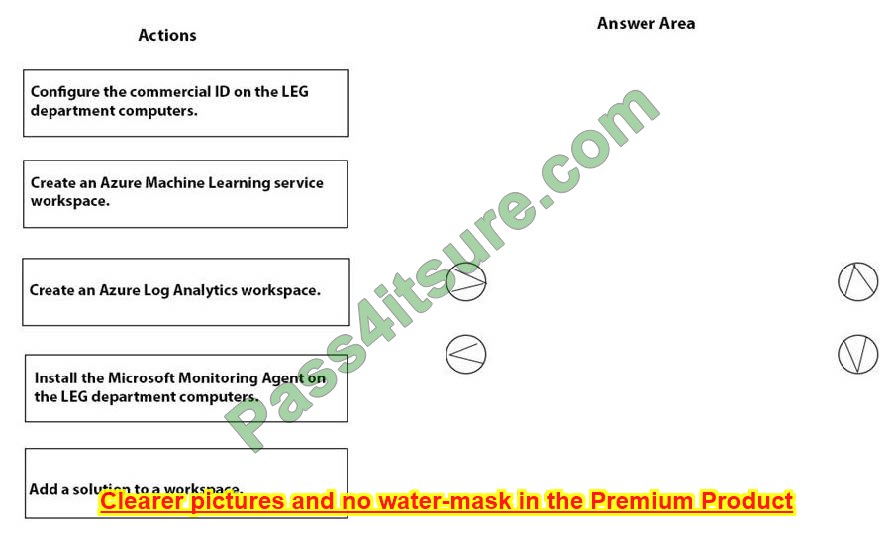
Correct Answer:
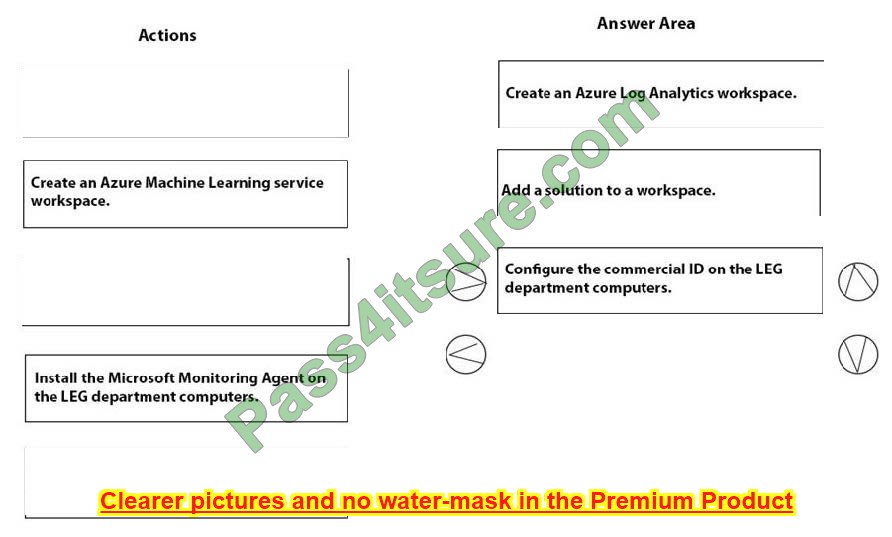
Reference: https://docs.microsoft.com/en-us/windows/deployment/update/windows-analytics-azure-portal
Q11:
HOTSPOT
You have a Microsoft Deployment Toolkit (MDT) deployment share named Share1.
You add Windows 10 images to Share1 as shown in the following table.
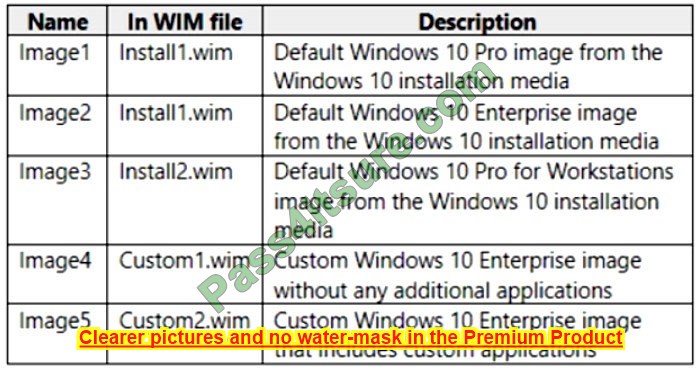
Which images can be used in the Standard Client Task Sequence, and which images can be used in the Standard Client Upgrade Task Sequence? NOTE: Each correct selection is worth one point.
Hot Area:
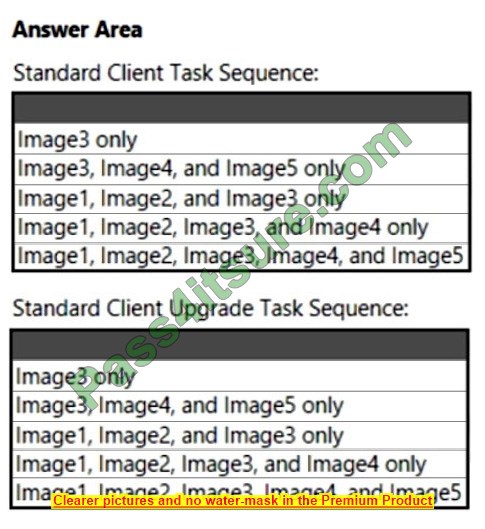
Correct Answer:
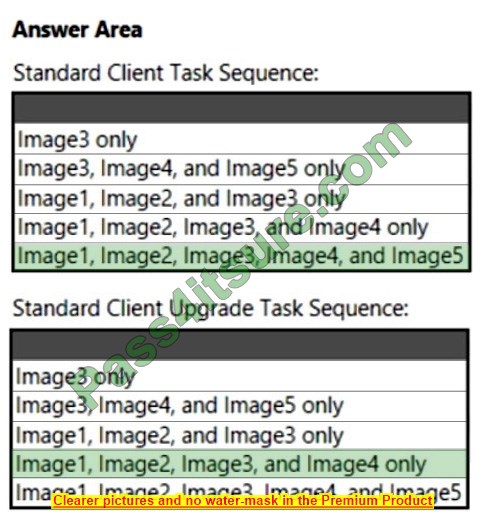
Box 1: Image1, Image2, Image3, Image4, and Image5.
All images.
Standard Client Task Sequence Standard Client task sequence. The most frequently used task sequence. Used for creating reference images and for deploying clients in production.
Box 2: Image1, Image2, Image3, and Image4 only.
Exclude image5 with applications.
Standard Client Upgrade Task Sequence
Standard Client Upgrade task sequence. A simple task sequence template used to perform an in-place upgrade from Windows 7, Windows 8, or Windows 8.1 directly to Windows 10, automatically preserving existing data, settings,
applications, and drivers.
Reference:
Q12:
Note: The question is included in a number of questions that depicts the identical set-up. However, every question has a distinctive result. Establish if the solution satisfies the requirements.
Your company has Windows 10 computers are enrolled in Microsoft Intune. You make use of Intune to manage the servicing channel settings of all company computers.
You receive an inquiry regarding the servicing status of a specific computer. You need to review the necessary policy report. Solution: You navigate to devise status via Device configuration.
Does the solution meet the goal?
A. Yes
B. No
Correct Answer: B
Note 1: Intune offers integrated report views for the Windows update ring policies you deploy. These views display details about the update ring deployment and status:
1. Sign in to the Microsoft Endpoint Manager admin center.
2. Select Devices > Monitor. Then under Software updates select Per update ring deployment state and choose the deployment ring to review.
Note 2: Use the Windows 10 and later feature updates (Organizational) report
To open the Windows 10 and later feature updates report and view device details for a specific feature updates profile:
In the admin center, go to Reports > Windows updates > select the Reports tab > select Windows Feature Update Report.
Note 3: To help you monitor and troubleshoot update deployments, Intune supports the following reporting options:
Reports in Intune:
Windows 10 and later update rings Use a built-in report that\’s ready by default when you deploy update rings to your devices.
Windows 10 and later feature updates In public preview Use two built-in reports that work together to gain a deep picture of update status and issues.
Reference: https://docs.microsoft.com/en-us/intune/windows-update-compliance-reports
Q13:
You have an Azure Active Directory (Azure AD) tenant named contoso.com.
You plan to use Windows Autopilot to configure the Windows 10 devices shown in the following table.

Which devices can be configured by using Windows Autopilot self-deploying mode?
A. Device2 and Device3 only
B. Device3 only
C. Device2 only
D. Device1, Device2, and Device3
Correct Answer: B
Self-deploying mode uses a device\’s TPM 2.0 hardware to authenticate the device into an organization\’s Azure AD tenant. Therefore, devices without TPM 2.0 can’t be used with this mode.
Reference: https://docs.microsoft.com/en-us/windows/deployment/windows-autopilot/self-deploying
Q14:
DRAG DROP
Your company uses Microsoft Intune. You have a Microsoft Store for Business account.
You need to ensure that you can deploy Microsoft Store for Business apps by using Intune.
Which three actions should you perform in sequence? To answer, move the appropriate actions from the list of actions to the answer area and arrange them in the correct order.
Select and Place:
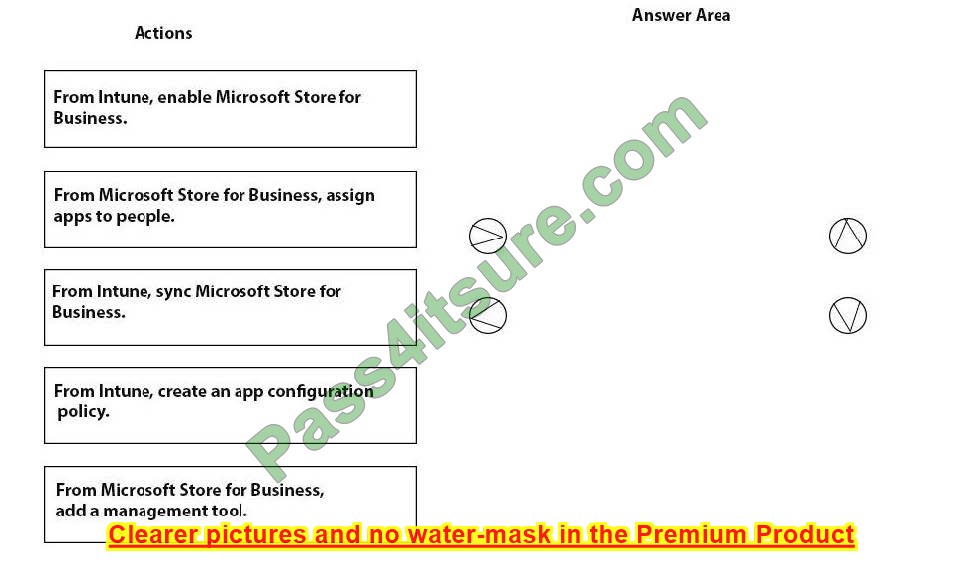
Correct Answer:
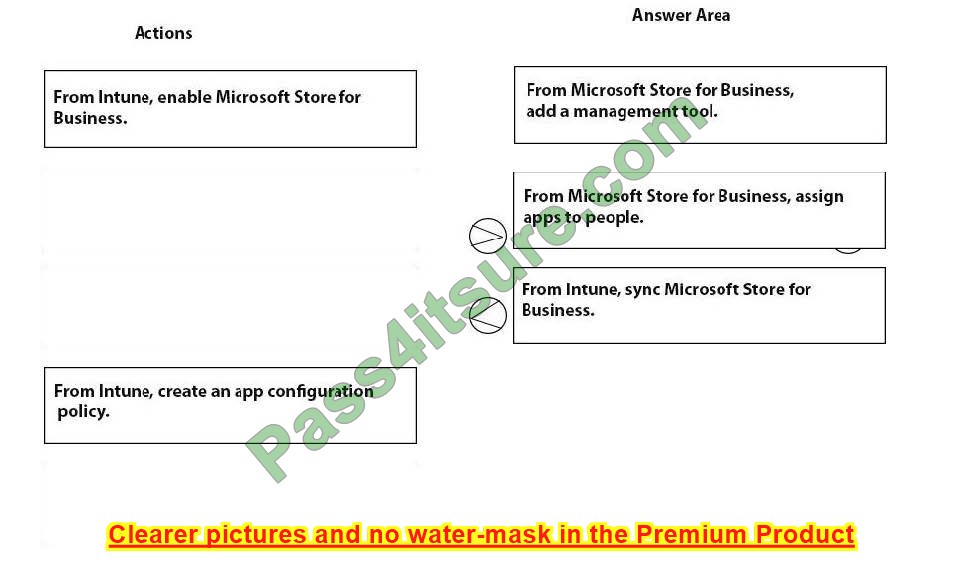
Q15:
HOTSPOT
You have a Microsoft 365 E5 subscription that uses Microsoft Intune.
You need to ensure that users can only enroll in devices that meet the following requirements:
1. Android devices that support the use of work profiles.
2. iOS devices that run iOS 11.0 or later.
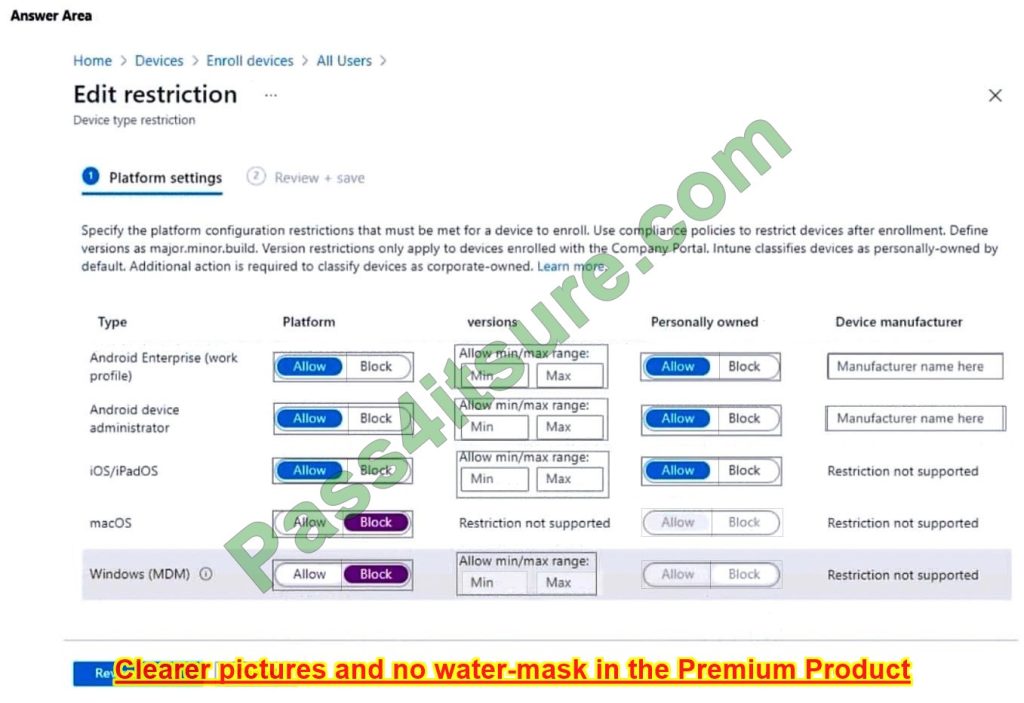
Which two restrictions should you modify? To answer, select the restrictions in the answer area. NOTE: Each correct selection is worth one point.
Hot Area:
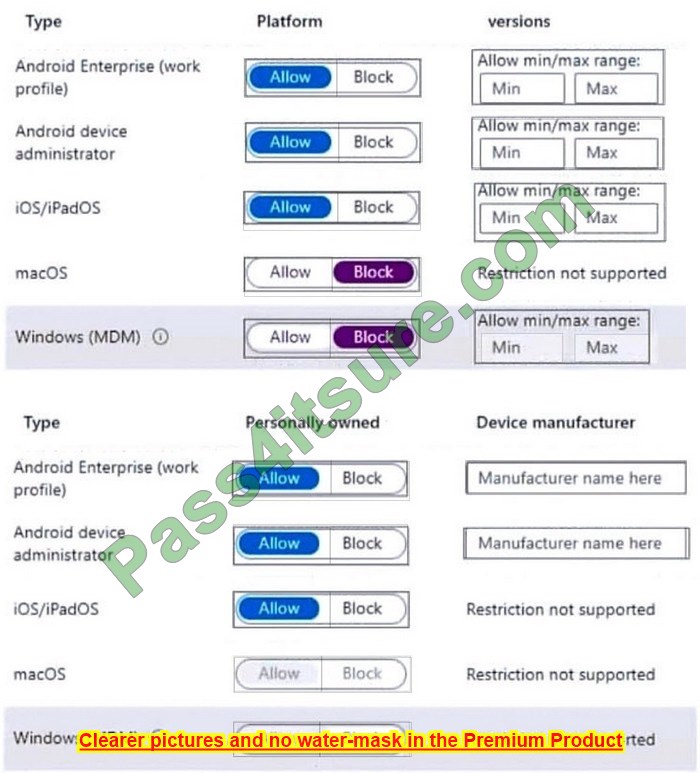
Correct Answer:
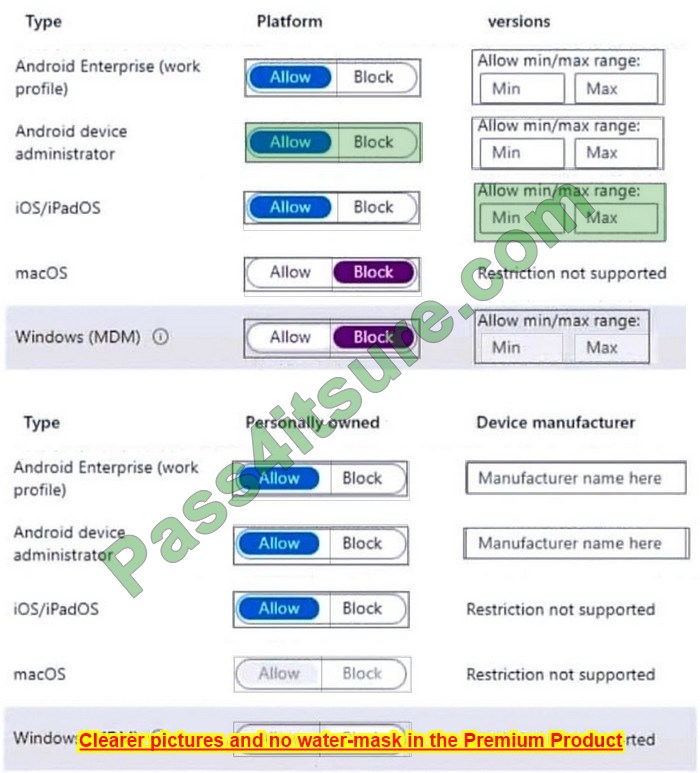
Box 1: Android device administrator, Platform: Block Restrict devices running on the following platforms:
Android device administrator
Android Enterprise work profile iOS/iPadOS macOS
Windows Note: If you allow both Android platforms for the same group, devices that support a work profile will enroll with a work profile. Devices that don’t support it will enroll on the Android device administrator platform.
Neither work profile nor device administrator enrollment will work until you complete all prerequisites for Android enrollment. Box 2: iOS/PadOS, Allow min/max Range: Min
Reference: https://docs.microsoft.com/en-us/mem/intune/enrollment/enrollment-restrictions-set
And the latest MD-101 pdf free download: https://drive.google.com/file/d/1kBcLVLPJ4ABqVwq-bE16ceGCXG_uYLuo/view?usp=share_link
The above free exam questions and answers are from Pass4itSure Free Share. For more 414+ exam questions, visit the full MD-101 dumps https://www.pass4itsure.com/md-101.html
Getting the best MD-101 dumps is just the first step, and you’ll need to practice hard to pass the MD-101 exam easily.

